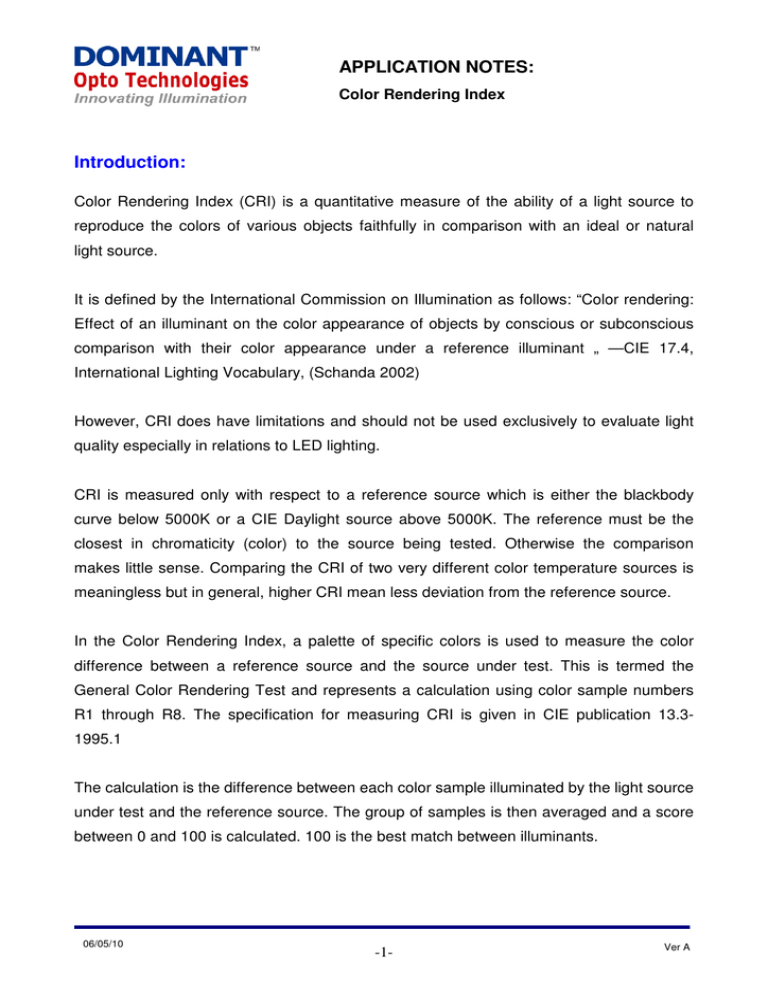Color Rendering Index - VerA
advertisement

APPLICATION NOTES: Color Rendering Index Introduction: Color Rendering Index (CRI) is a quantitative measure of the ability of a light source to reproduce the colors of various objects faithfully in comparison with an ideal or natural light source. It is defined by the International Commission on Illumination as follows: “Color rendering: Effect of an illuminant on the color appearance of objects by conscious or subconscious comparison with their color appearance under a reference illuminant „ —CIE 17.4, International Lighting Vocabulary, (Schanda 2002) However, CRI does have limitations and should not be used exclusively to evaluate light quality especially in relations to LED lighting. CRI is measured only with respect to a reference source which is either the blackbody curve below 5000K or a CIE Daylight source above 5000K. The reference must be the closest in chromaticity (color) to the source being tested. Otherwise the comparison makes little sense. Comparing the CRI of two very different color temperature sources is meaningless but in general, higher CRI mean less deviation from the reference source. In the Color Rendering Index, a palette of specific colors is used to measure the color difference between a reference source and the source under test. This is termed the General Color Rendering Test and represents a calculation using color sample numbers R1 through R8. The specification for measuring CRI is given in CIE publication 13.31995.1 The calculation is the difference between each color sample illuminated by the light source under test and the reference source. The group of samples is then averaged and a score between 0 and 100 is calculated. 100 is the best match between illuminants. 06/05/10 -1- Ver A Color Rendering Index Chart 1: CRI Color Palette Name Appearance under daylight Color Tone Appearance under daylight Name R1 Light greyish red R5 Light bluish green R2 Dark greyish yellow R6 Light blue R3 Strong yellow green R7 Light violet R4 Moderate yellowish green R8 Light reddish purple Color Tone The following are typical CRI values for commonly used light sources. US Energy Star has defined the requirement of CRI>75 for indoor luminaries. Source CCT(K) CRI Incandescent/Halogen Light Bulb 3200 100 T8 Linear Fluorescent - 75 - 85 Compact Fluorescent - 82 Standard Metal Halide - 65 Standard LED Luminaires (Cool White) 6000 70 Cool White Linear Fluorescent 4200 62 Standard HPS - 22 Clear Mercury-vapor 6410 17 Low Pressure Sodium (LPS/SOX) 1800 ~5 CRI For White LED Majority of current available white LED in the market is produced by a blue InGaN chip coated /surrounded by yellow phosphor. This yellow phosphor will convert part of the blue ray to yellow light. The mixture of blue light and yellow light will be perceived by human eye as white light. Due to missing or inadequate red light in this type of white color mix, the General CRI for typical cool white LED is in the range of 70. 06/05/10 -2- Ver A Color Rendering Index General CRI ~70 for cool white LED There are 2 solutions to overcome this low CRI issue on LED lighting: 1.) Addition of red phosphor to the LED phosphor system in order to generate some red ray element to improve the CRI Pros: No change on current LED circuitry design, only exchange to LED with higher CRI. Cons: Red phosphor addition usually will cause the LED brightness drop by ~10%-15% due to lower conversion efficiency. 2.) Include red LED in the LED Luminaire design together with cool white LED in order to introduce red ray element. Pros: Allow tunable color temperature to some extent by controlling the red LED intensity. Cons: More complicated LED circuitry design which now require to drive 2 different type of LED in single luminaire. 06/05/10 -3- Ver A Color Rendering Index Improved Phosphor Mixture With Addition Of Red Phosphor In order to enhance the red color content, red phosphor and other materials can be added into the phosphor mixture. Dominant too has a series of product using improved phosphor mixture recipe. Products with this enhanced CRI are able to achieve typical CRI of 80 and a minimum of 75 for all color coordinates. The higher CRI is due to the improved content in the red color region as illustrated by the color spectrum. A typical example is as illustrated below. 1.00E-04 9.00E-05 8.00E-05 7.00E-05 6.00E-05 5.00E-05 4.00E-05 3.00E-05 2.00E-05 1.00E-05 0.00E+00 300 400 500 600 700 800 900 Design Idea Using Red LED To Improve The CRI For Low CRI Cool White LED Background: This experiment is to study the improvement in CRI by introduce Red element into Cool White LED Module. The experiment is carried out by using one customized PCB with one SPNova (Cool White) LED and four pieces Primax (Red) LEDs as a single cell. The same design concept can be expanded to multiple cells based on customer intended light output. 06/05/10 -4- Ver A Color Rendering Index Figure 1: PCB with One SPNova (Cool White) LED and surrounding Four Pieces Primax Red LEDs in a single cell. Primax (Red) LEDs SPNova (Cool White) LED Table 1: Measurement data for Luminous Intensity & Color Rendering Index Luminous Intensity, Iv(mcd) Cool White + Red Red %Red 21159.85 0.00 0.00 21353.26 193.41 0.91 21424.67 264.82 1.24 21578.73 418.88 1.94 21680.18 520.33 2.40 21776.96 617.11 2.83 21878.04 718.19 3.28 21973.39 813.54 3.70 22065.15 905.30 4.10 22194.09 1034.24 4.66 22247.01 1087.16 4.89 22350.98 1191.13 5.33 22454.11 1294.26 5.76 22530.80 1370.95 6.08 22644.76 1484.91 6.56 22709.85 1550.00 6.83 Color Rendering Index CRI 68.9 69.0 70.8 71.8 73.1 74.3 75.6 76.4 78.1 78.5 79.8 81.2 81.7 82.9 83.5 84.1 The drive current for the red LED is increased gradually in order to enhance CRI. Comment: Measurement data above is with reference to SPNova (Cool White) LED and with increment of Red element. CRI can be improved from 68.9 to 84.1 by addition of 6.8% of Red element. 06/05/10 -5- Ver A Color Rendering Index Figure 2: Color Shift from 0%Red to 6.8%Red Intensity Dominant WhiteBin Structure 0.42 4500K 0.40 Direction of CCT shift 0.38 5000K UM 5650K UN VM 0.36 6300K WM UO VN 7000K XM WN 0.34 XN WO XO 0.32 10000K UP VP WP WQ XP YO VO 0.30 YA 0.28 0.26 0.26 0.28 0.30 0.32 0.34 0.36 0.38 Observation: Correlated Color Temperature (CCT) will shift from ~7500K to 5680K with the increment of red light element, that is, the mixed light output will become warmer. Figure 3: Color spectrum of mixture of white and red LED. 06/05/10 -6- Ver A Color Rendering Index Summary There are multiple publications have pointed out the inadequacies of the CRI metrics to quantify the true color rendering effect especially for solid state lighting. Currently several organization including the CIE & US Lighting Research Center is still in the midst of developing a better measurement method to replace existing CRI metrics. Until then, lighting designer is advised to base on their own judgment and actual illumination comparison for LED light source selection instead of the measured CRI value. 06/05/10 -7- Ver A


